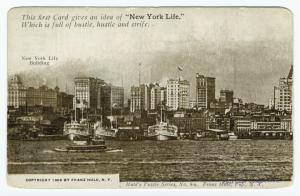 Most of the property in this tract, mellowed by romance and favored by nature, was beautifully wooded, the trees towering to a great height and from the owners the territory took the name of Jones' Wood.
Most of the property in this tract, mellowed by romance and favored by nature, was beautifully wooded, the trees towering to a great height and from the owners the territory took the name of Jones' Wood. The Hillock known as Dead Man's Rock marked its beginning some 75 years ago. In later times the site of this landmark became ignoble in police annals as the boundary of Battle Row. This region was the last fastness of the forest primeval that once covered the rocky shores of the East River and its wildness was almost savage.
In the infant days of the colony it was the scene of tradition and fable having been said to be a favorite resort of the pirates who dared the terrors of Hell Gate and came here to land their treasures and hold their revels. The gifted pen of Irving* has described it as "a new creation" to the eyes of voyagers from the settlements, for no signs of human thrift appeared to check the delicious wildness of nature which here reveled in all here luxuriant variety.
The hills along the river were adorned with the vigorous natives of the soil: the lordly oak, the generous chestnut, the graceful elm, while here and there the tulip tree reared its majestic head, the giant of the forest. Where later were seen the gay retreats of luxury, our author muses, villas half buried in twilight bowers, whence the amorous flute oft breathed the sightings of some city swain, there the fish-hawk built her solitary nest on some dry tree that overlooked her watery domain. The timid deer fed undisturbed along these shores now hallowed by the lover's moonlight walk and printed by the slender foot of beauty; and a savage solitude extended over these happy regions, where now are reared the stately towers of the Joneses, the Schermerhorns and the Rhinelanders. Its shores were renowned for its fisheries and under the shadow of its rocky bluff and overhanging oaks the youth of a former generation cast their lines and waited for bites.
In the "opening years of the last century" the wood became "a place of delight" to the pleasure seekers from the distant city. The property was very attractive for the purpose and the views from the shores highly interesting and varied. The above quotation is taken from two contemporary writers but failure has met the endeavor to ascertain data of such early date. The place, however, was a conspicuous landmark and as such became a subject of contention during the endeavor to acquire a large city park. The advisability of acquiring land for that purpose was raised by Ambrose C. Kingsland, the Mayor, in a message to the Common Council under date of May 5th, 1851. (Pro. Board of Aldermen. XLII:32). The people and their representatives were divided between this locality and a more central one. A preamble and resolutions of the Common Council against Jones's Wood and in favor of Central Park were presented in the Senate at Albany on June 17th, 1853. (Com. Adtr. June 18th).The same paper of June 23rd contained the report of a Select Committee of the Senate dated the 21st, in favor of the acquisition of the former site and stating that it contained an area of 156 acres. Senator Cooley on the following day submitted an elaborate written minority report in opposition thereto and in favor of a central location. On July 1st Senator Beekman stated that, although he understood that the owners of Jones's Wood were opposed to its being selected, he thought "the great plea of public necessity" required its acquisition. Cooley defended the minority report on the ground that the prevalence of rowdy's was such that the wives and families of visitors to the park would not be safe, five or six miles away from the inhabited parts of the city.
Continue: Jone's Wood (2)
.

No comments:
Post a Comment